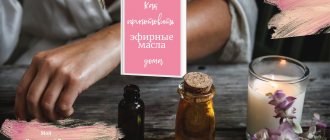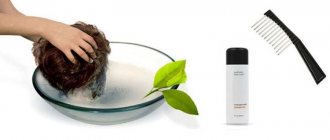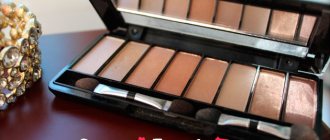Issues discussed in the material:
- What is mehendi and what is its history
- Benefits of mehendi designs
- What do mehendi designs mean?
- What is mehendi and how to do it at home
Even if you are wondering what mehendi is, this does not mean that you have not seen such designs before. Exotic patterns on the hands and wrists of oriental beauties have captivated with their grace since ancient times. And therefore, this exquisite body art, performed with ordinary henna, began to appear more and more often in the images of girls around the world.
However, you should not consider mehendi only as henna designs. Eastern beauties put a certain meaning into each curl. In this article you will learn what mehendi is, how to interpret its patterns and how to make them part of your image.
What is mehendi and what is its history
What is mehendi or mehndi is known to many. This is the art of decorating your body with designs made with natural henna, which came to us from the East. The word “mehndi” is translated from Hindi as “henna”. Researchers have not yet been able to establish exactly in which country this trend was born. According to historians, it could be India or Ancient Egypt. Centuries have passed since those times, but the technique of applying mehendi (in other words, camphor or coffer) has remained unchanged. Compared to classic tattoos, which are common in European countries, this painting does not damage the skin and cannot cause any disease.
Recommended reading:
- What not to do after eyelash extensions
- Which eyelash extension to choose for yourself
- Eyelash care: advice from professionals
There are several reasons why this cultural tradition has become widespread throughout the world. Some girls see this as a way of self-expression, a chance to stand out from the crowd, a fashion trend. Others who have studied the matter more deeply know that with the help of fantastically expressive drawings you can protect yourself from negative influences.
Today you can find four styles of mehendi - Arabic, Asian, Indian and North African (Moroccan):
- Moroccan style is characterized by many geometric strict lines and floral motifs. Henna is a natural antiseptic, so in hot countries you can meet women with completely colored feet and palms.
- Arab mehndi artists use floral themes. Usually the body is decorated with patterns and scenes, the basis of which are small flowers.
- Indian traditional paintings present a wide variety of symbols and images, into which the masters attach a certain meaning, since they are usually performed to participate in some ritual or holiday. In the drawings you can see animals, interlacing geometric shapes and floral motifs. Often the feet and hands are completely covered with painting, and then they look like socks or gloves.
- Asian style is reminiscent of Indian. The difference is that henna is also applied to the tips and pads of the fingers, as well as to the sides of the hands and feet.

The version of the origin of mehendi in Ancient Egypt is the most popular. There are many facts that among rich and noble ladies it was customary to decorate various parts of their bodies with henna patterns. Men subsequently liked this tradition too. In addition, it is known that the mummies of Egyptian rulers were also decorated with sacred patterns that protected them on their journey to the afterlife.
After some time, representatives of the lower strata of Egyptian society began to paint their bodies with mehendi patterns, since acquiring henna was not difficult. Then this technique began to be used in the Middle East, North Africa and Asian countries.
In Central Asia and India, ordinary natural henna is more often used, so the designs come out in brown or reddish shades. In Morocco and other North African countries, henna is used with the addition of coal or ash - the patterns on the skin are darker and even black. In many countries where mehendi is popular, during pregnancy women have patterns applied to their ankles and stomach to protect the fetus from evil eyes.
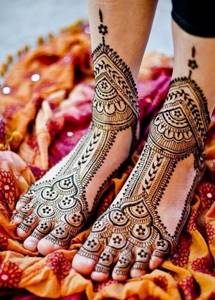
According to Islamic traditions, only brides and married women could decorate themselves with such painting. Muslims were forbidden to put tattoos on their bodies, since after the procedure the body was no longer the same as Allah intended it to be. This was especially true for women. They could demonstrate the exquisite beauty of mehendi only to their husbands. Gloves and socks hid patterns applied to the hands and feet, which were considered too intimate decorations and were intended only to intensify passion in the marital bedroom.
Indian women love mehendi. In this country, three-year-old girls already decorate their arms and legs with bright patterns. More often than not, girls wear designs made with henna, but you can also meet men with body paintings.
For girls who were destined to become brides, applying mehendi to their skin took on a special meaning. Symbolic images on the arms, shoulders, legs and feet, made by experienced older relatives, were supposed to initiate the future wife into the secret knowledge necessary in marital relations. This ritual could last five hours or longer, sometimes even taking two nights, as they tried to make the painting as dense, sophisticated and bright as possible. If the henna remained, it had to be buried in the ground so that the husband would never cheat on his wife.
Secrets of drawing durability
Before we talk about how long we can maintain openwork curls on our body, we need to find out the features of this technique and what factors influence the quality of the design.
Henna pigments do not penetrate the layers of the epidermis; they remain on the surface, therefore they are removed along with dead epithelial cells in just a few weeks.
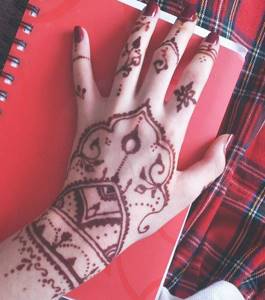
For better penetration of paint into cells, it is recommended to carry out the following set of measures:
- pre-steam the skin at the site of staining to open the pores and into which the molecules of the coloring composition will be securely fixed;
- clean from dirt using detergents; you can use preparations for deep cleansing;
- to remove dead particles of the dermis, perform peeling or scrubbing;
- degrease the surface with alcohol-containing liquids.
It is especially important to provide a new tattoo with care from the first minutes. If you want to extend his life, you should know how to care for fresh mehendi immediately after the procedure.
- Never wash off the dried layer of henna with water. This will damage the structure of the paint and some of it will come off the skin.
- For better fixation, apply a special oil to the design, which can be purchased along with all the accessories for mehndi in an eastern goods store. Feel free to use other vegetable oils, but their properties in this regard will be somewhat worse.
- Over the next 4-8 hours, protect the pattern from contact with water.
- The next day, treat the stained area with mustard or olive extract.
If you do everything correctly, after a couple of days you will see a bright, rich image. This is exactly how long it takes natural henna to transition from a brown shade to a darker chocolate shade.
Benefits of mehendi designs
The explanation why women and men in different countries love mehendi lies in its benefits. It’s not for nothing that this type of art only becomes more popular with every century. Before you decorate your skin with painting, it won’t hurt to learn more about what a mehendi tattoo is, what its advantages and features are.
Advantages:
- It has a hypoallergenic composition. Henna is a natural substance, it does not irritate the skin, there is no itching or redness. At the end of the procedure, natural oil is applied to the dermis.
- Hides skin imperfections. Girls are especially sensitive to looking their best at an event that is significant to them. An openwork large mehendi pattern helps to hide birthmarks, acne, pigmentation or a scar.
- Comfortable conditions when creating a drawing. For the client, performing mehendi and removing patterns is absolutely painless. During the session, the master does not use needles or painkillers. No discomfort. Body paint can gradually come off on its own, without outside intervention, simply by being peeled off during bath procedures.
- It's easy to change your look. The good thing about henna painting is that, compared to classic tattoos, the design can be changed every two weeks. The main thing is to follow the rules for caring for mehendi. Preparation for replacement does not require long-term recovery with expensive procedures.
- Henna has a beneficial effect on the skin and the body as a whole. We have already talked about the antibacterial properties of the dye. In addition, application of the product promotes the healing of minor damage, cracks, and cuts. It contains beneficial components that nourish the skin, so henna is used to treat skin diseases, and its smell soothes headaches.
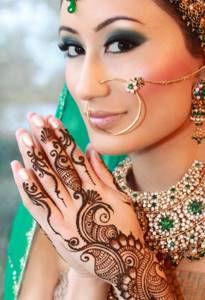
The features of mehendi skin decoration include the following:
- Short term. The image lasts three to four weeks and then gradually wears off, no matter how carefully you follow the care instructions.
- A small number of shades. The natural colors of henna are brown, dark brown and black. In some cases, for example, on a wedding mehendi, the design can be made with white hypoallergenic acrylic paint, but this is more of a body art rather than a classic option.
- Mehndi requires careful care. The drawing is made with natural paint, a natural preservative is also used for fixing, so some effort must be made to ensure that this beauty lasts as long as possible.
- Limited choice of places on the body to create mehndi. It is best to apply images on areas with rougher skin that are in less contact with clothing, for example, on the ankles, back, wrists, back of the head and shins. Making high-quality jewelry yourself will probably be inconvenient, so it’s worth finding a good specialist for this purpose.
What do mehendi designs mean?
| Drawing | Interpretation |
| Flowers | Most often it is customary to decorate yourself with floral motifs. These are symbols of femininity, fragility and wealth of the inner world. Images of fruits and flowers are associated with joy and happiness |
| Turkish cucumber | Patterns with Turkish cucumber (paisley, buta, tear of Allah) symbolize fertility, development, movement. In the distant past, only representatives of the nobility were allowed to do such mehendi. In the Indian tradition, such drawings were used to decorate the body before the wedding, wishing the newlyweds a prosperous and rich life. This symbolism can be used not only by brides, but also by those who dream of attracting abundance into their lives. It is typical for a wedding pattern to complement the image of Turkish cucumbers with small dots, which means the love of the bride for the groom |
| Corn | This is a sign of abundance, prosperity and happiness in the family and home. A wedding decoration sometimes depicts a Turkish cucumber with a grain placed inside |
| Flower buds, stems, vines | Drawings with flower buds are associated with the beginning of a new life. Those who are now in love can decorate themselves with them. The same symbolism is carried by patterns with climbing plant stems. In addition, they are associated with protection from negativity. By the way, this is the meaning of the swastika. Those who choose the image of vines are distinguished by perseverance and perseverance in the pursuit of the goal |
| Lotus | This flower belongs to the wedding symbolism of mehendi. It means purity, virginity, femininity. The lotus is depicted on the girl’s hand and symbolizes the speedy continuation of the family, fertility, the union of the energy of a man and a woman, glory, luck, success. During pregnancy, lotus images are also found on women’s bodies. |
| Birds | Patterns with birds in mehendi - what is it and why are they depicted? The bird is always a symbol of height, flight, dreams, speed, sky, freedom and excitement |
| Feather | Feather in mehendi is used by extraordinary and bright people. Love of life, joy from every day, the ability to think broadly and freely, willfulness - all this reflects the character of the person who chose this symbol |
| Peacock | The peacock design signifies the sun, pride, beauty and grace. A person who prefers a similar pattern strives to create a regal and at the same time romantic image. Peacock is a symbol of glory, greatness, happiness, wealth. Musicians, poets, artists and other creative personalities who care about fame and success often decorate themselves with this sign. The image of an earring can also reveal the talents and abilities of creative people |
| Owl | Mehendi with an owl pattern symbolizes wisdom, a deep and flexible mind, firmness in decision-making and power. Initially, in order to decorate yourself with such a symbol, you had to be a very influential and rich person. Nowadays, this also requires determination and courage. |
| Martin | Such an image is hope, the arrival of spring, the expectation of happiness and success. This sign is associated with luck and luck |
| Elephant | The image of an elephant has many meanings. It is believed that such henna mehendi testifies to power, intelligence, wisdom, longevity, glory, victories and military valor. India is a country where elephants have always had a special position. They symbolize kindness and mercy. Surely many people know that the god of wisdom and innocence Ganesha has the head of an elephant |
| God Shri Ganesha | Mehendi can depict Shri Ganesha, an Indian god who has the head of an elephant and the body of a child. The symbol speaks of wisdom, prosperity, innocence, spontaneity and cheerfulness. Brides decorate themselves with this pattern before the wedding or apply it during pregnancy. In addition, it is suitable for someone who has decided to start a new business and asks the Higher Powers to support him on the path to success. |
| Fish | This means anxious waiting and dreams of love. A fish pattern painted on the palm helps make a wish come true |
| Snails, shells | Images of snails, shells and umbrellas indicate a person’s desire to find a safe place where he can hide from problems |
| Chariot | If a chariot is depicted on the skin of the hand, then this indicates a person with a flexible mind and broad outlook. |
| Crescent | It is believed that this mehendi is suitable for young girls and brides as a symbol of exquisite beauty and tenderness |
| Sun | Mehendi with the image of the Sun testifies to infinity, immortality, wisdom and the desire to know all the secrets and mysteries of the universe |
| Bracelets | Bracelets made with henna can most often be found on the wrists of women who dream of a life partner, as well as those who strive for success in love. |
| Triangle | This sign protects from anxiety and worry, helps to avoid natural disasters and diseases. |
| Octagon | The image of an octagon serves as a powerful amulet, reflecting negativity from any side: southern, northern, western, eastern, as well as all in between |
| Stars: five-pointed, six-pointed | Images of stars are very symbolic. The five-pointed symbol represents the union of the elements: earth, water, air, fire and sky. There are differences here with the Chinese tradition of Feng Shui. This symbol reflects hope for help from above. Mehendi with a six-pointed star means balance between masculine and feminine energies |
| Vishnu (disc) | The sign of Vishnu, which is depicted in the form of a disk, is applied by men to mean courage, bravery, power and strength, and by women as a symbol of fidelity and chastity. |
How to do mehendi at home
So, we have looked at what mehendi is and how long the pattern lasts on the skin. In order for the decoration to be completed flawlessly, you need to carefully prepare for the session. What needs to be done before applying painting to the skin?

Let's look at all the required procedures one by one:
- Using depilation, get rid of all unwanted hair in the part of the body where the image will be made. This is important because the hairs will also be dyed, and the pigment will remain on them longer than on the skin. The hair creates an obstacle to the penetration of the coloring paste into the dermis, so a high-quality and clear pattern will not be obtained.
- Cleanse the skin of dead cells using a scrub (peeling), and for degreasing, you can use special preparations used for waxing.
- Perform an allergy test. Henna is considered a hypoallergenic substance, but individual intolerance still occurs. Fresh wounds, cuts and injuries are also recommended to be treated before applying mehendi.
- Collect on the desktop a set of necessary materials, tools and equipment:
- Different shades of henna that you will need for creativity. Ready-made henna packages are available for sale, from which the paste is squeezed out through a narrow spout.
- A tube of oil, which is used to fix the pattern, and several lint-free napkins to blot dry paint.
- A set of stencils or ornaments with a sticky layer on one side for selecting a design.
- Cleansing cosmetics (spray, lotion, gel) that allow you to deeply cleanse the skin.
- Disinfectants that prepare the skin for mehendi.
- Peeling (scrub) that thoroughly cleanses the selected area of skin.
- A small piece of film that will be needed to cover the area of skin with the mehendi pattern applied for deep penetration and fixation.
If you have everything ready, then you can start creating the decoration!
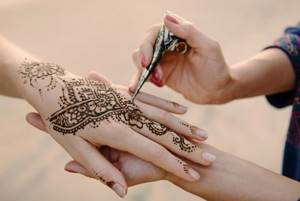
It is necessary to take into account the property of henna to be absorbed almost instantly into the skin, so to remove imperfections, prepare cotton swabs and lemon juice. You only have a minute to fix it, otherwise marks will remain. The paint will come out of the cone evenly and you will get an even line if you gently press on the henna package without touching the skin with the nose. To obtain a lighter shade, apply a thin and wide layer. And to get a thick and bright color, apply one layer first, and after it has absorbed a little, make another line on top.
How to dye your hair with henna
The color obtained after dyeing with henna can range from light red to deep chestnut, depending on the exposure time and the original hair color. The brightest shades are obtained on light hair.
It is useful to apply a little rich cream along the hairline on the face - it will prevent henna from staining the skin. And it’s better to use gloves, maybe surgical ones, so as not to get your hands dirty.
As a rule, one packet of henna is enough for short hair, two for medium hair, and three or four for long hair.
Before dyeing your hair with henna, you should wash your hair well, do not use products after shampoo, and dry it slightly. If your hair is dry during dyeing, it is better to slightly moisten it.
Henna powder is poured into a ceramic, plastic or glass container, poured hot, but not boiling! water (70-90°C) in an amount sufficient to obtain a homogeneous mass of sour cream consistency. The resulting mixture is applied to the hair with a dye brush.
It is best to start dyeing your hair with henna from the back of the head - it is the “coldest”, so it needs more time to absorb the dyes. Finish painting at the top of the head - this area absorbs the paint the fastest. After applying henna, an insulating cap is put on the head.
Henna should be kept on the hair for 20-40 minutes - the time is selected depending on the desired degree of coloring: the longer the henna acts on the hair, the darker and more intense the color turns out.
At the end of the exposure time, the henna is washed off the hair with warm water without shampoo until the water becomes completely clear. Hair should then be dried in the usual way.
After dyeing with henna, it is best not to wash your hair for 3 days, otherwise the resulting color will become much less bright and saturated. In the future, the hair is tinted with henna as the roots grow or as desired.
Video on dyeing hair with henna
How to dye your hair brown with henna | Gray hair:
We paint over gray hair with natural dyes







